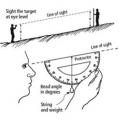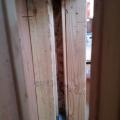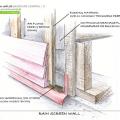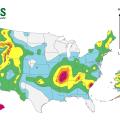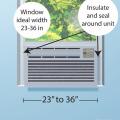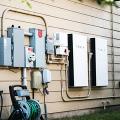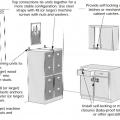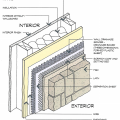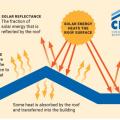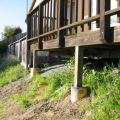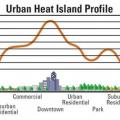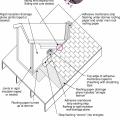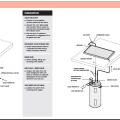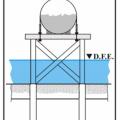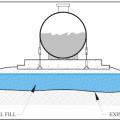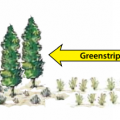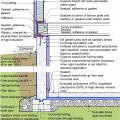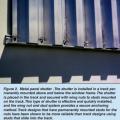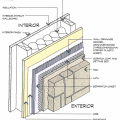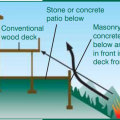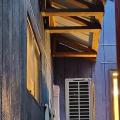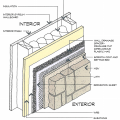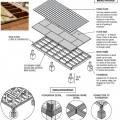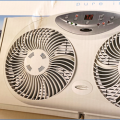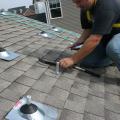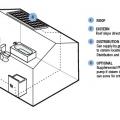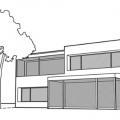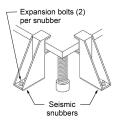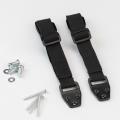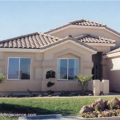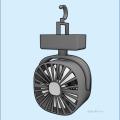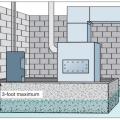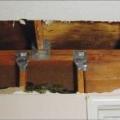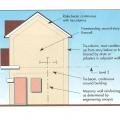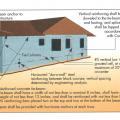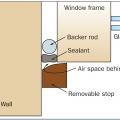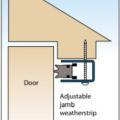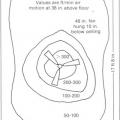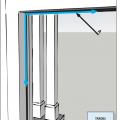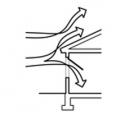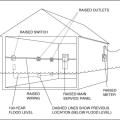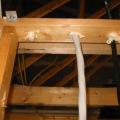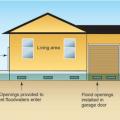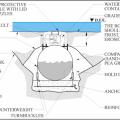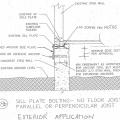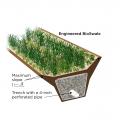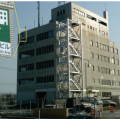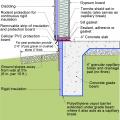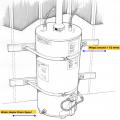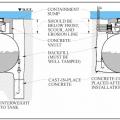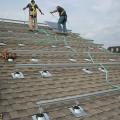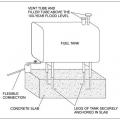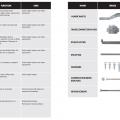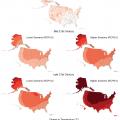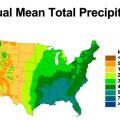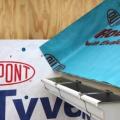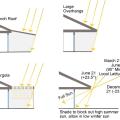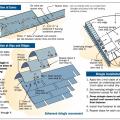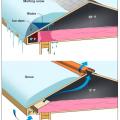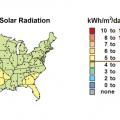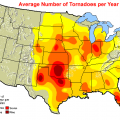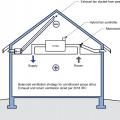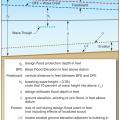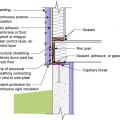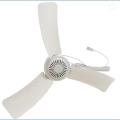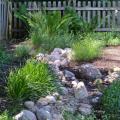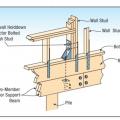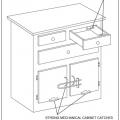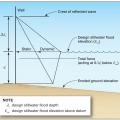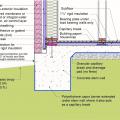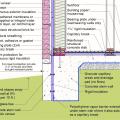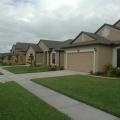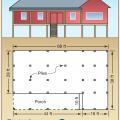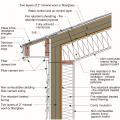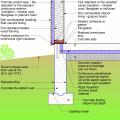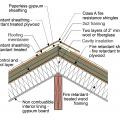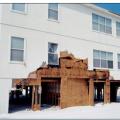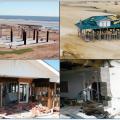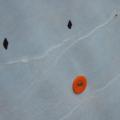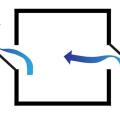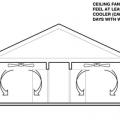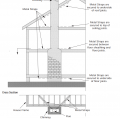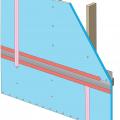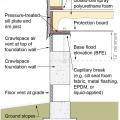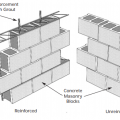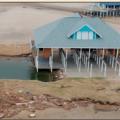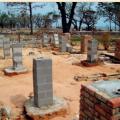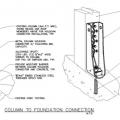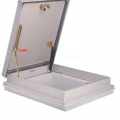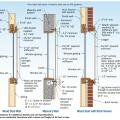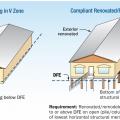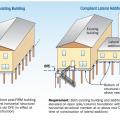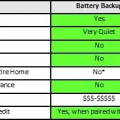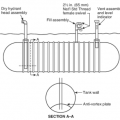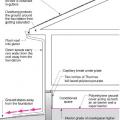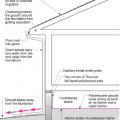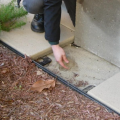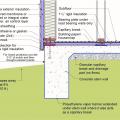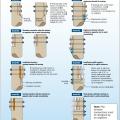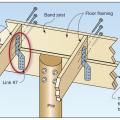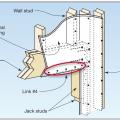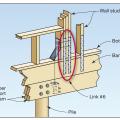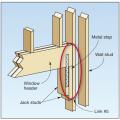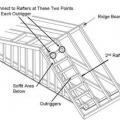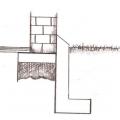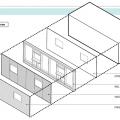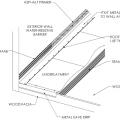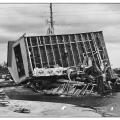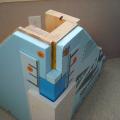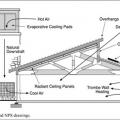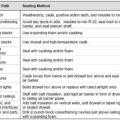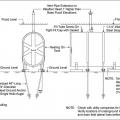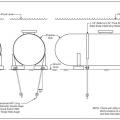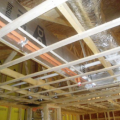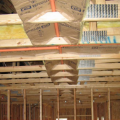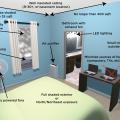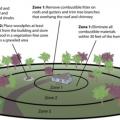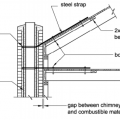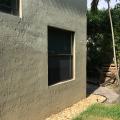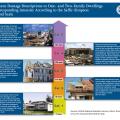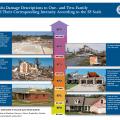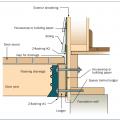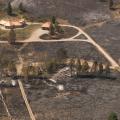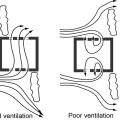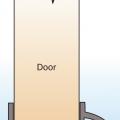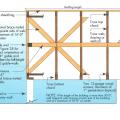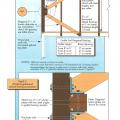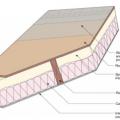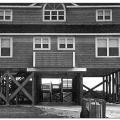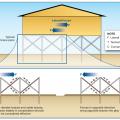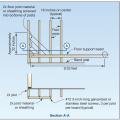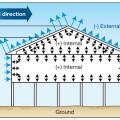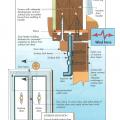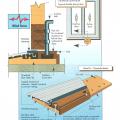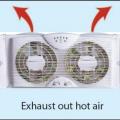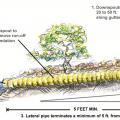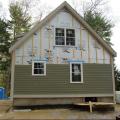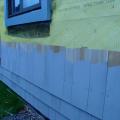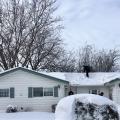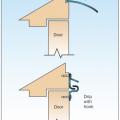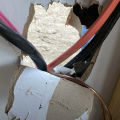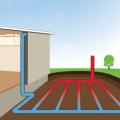Showing results 1 - 250 of 1165
Example of the advanced framing technique, double-stud wall cavity, which will later be filled with blown insulation
Impervious surfaces like patio slabs, sidewalks, and driveways that are within 10 feet of the home should slope away from the house.
Install mesh insect barrier along the bottom of the rain screen behind the exterior cladding of above-grade walls
These folding louvered porch doors provide effective shade from low-angle east and west sunlight and can open for views; the photovoltaic panels overhead allow in filtered natural light
A 1- and ½-story home with a room located in the attic and the thermal boundary located at either a) the walls and ceiling of the attic room with small vented attic spaces or b) the roof line for an unvented attic
A 5,000- 6,000 Btu/hr air conditioner drawing about 500 watts can be installed in one window of a designated cool room (it is important that the installation is insulated and well-sealed
A battery storage system can provide reliable back-up power during a grid power outage
A battery storage system's capacity is shown using three different usage approaches.
A combination of brackets and self-locking drawers. Drawer closures should be used to protect the home during seismic events.
A cone or disc of plastic or sheet metal can be installed on pipes and downspouts to prevent rodents from climbing up the outside and gaining access to the roof
A continuous drainage mat rainscreen made from vacuum-molded plastic provides uniform support for the siding and allows moisture to flow horizontally and diagonally in addition to vertically.
A continuous load path uses structural connections to transfer horizontal and vertical loads from the roof to the foundation to help keep the building intact in high-wind and seismic events
A cool roof utilizes materials with high solar reflectance and thermal emittance to reflect solar energy and reduce heat gain to the home
A cool room should have low enough heat gains to be easily cooled by a small single-zone cooling system such as a mini-split or a window air-conditioner as shown here
A Corsi-Rosenthal Box is a highly effective DIY air cleaner made of easy to obtain materials such as HVAC filters, a box fan, cardboard, and tape
A cross-section of a vinyl-framed window showing metal reinforcement which helps support the window and prevent collapse if exposed to heat from a fire.
A deck or other attached structure located at the top of a slope with vegetation underneath is at high risk of ignition during a wildfire
A dense concentration of buildings and pavement can create the Urban Heat Island Effect, where local temperatures can be several degrees higher than the surrounding areas
A dormer with an openable window (not shown) can provide access to the roof if flood waters rise too high and too quickly; the dormer should be properly insulated, flashed, and air sealed
A dry hydrant is a pipe a homeowner can have installed in a natural water source on their rural property to provide easy access to the water by firefighting crews.
A drywell, shown here used for downspout catchment, can also be used to receive water from a French drain.
A flat plate solar hot water system heat potable water in a glass covered collector that sits on the roof.
A French drain contains a perforated drain pipe wrapped in rock and landscape fabric.
A fuel tank elevated above the design flood elevation on a platform in a high velocity flow area.
A fuel tank is strapped onto a concrete slab at the top of compacted fill above the DFE.
A fuel tank should be anchored with ground anchors designed for site conditions to maintain secure connection to its base in a flood or earthquake
A gable end failure due to improper bracing caused collapse of most of the trusses on this roof under hurricane force wind conditions.
A green strip is a type of fuel break planted with less flammable vegetation; e.g., crested wheatgrass.
A layer of pea gravel or crushed stone, 4 inches thick and sloped 5%, provides a pest-resistant ground break around the perimeter of a slab foundation
A layer of pea gravel or crushed stone, 4 inches thick and sloped 5%, provides a pest-resistant ground break around the perimeter of a basement foundation
A low-sloped shed roof with the thermal boundary located at either a) the flat ceiling with a vented attic or b) the roof line for an unvented attic
A masonry chimney is reconstructed to withstand seismic forces by adding an insert to the existing firebox
A masonry chimney is reconstructed to withstand seismic forces by completely retrofitting the firebox and chimney using light-frame construction on the top of the foundation
A masonry chimney is reconstructed to withstand seismic forces by maintaining the current firebox but replacing the chimney section with a metal flue and light-weight chimney enclosure.
A masonry chimney is shortened and capped at roof level to reduce its chances of detaching in high winds or earthquakes; the fireplace can no longer be used.
A metal storm panel is installed in a track permanently mounted above and below the window frame and secured with wing nuts to studs mounted on the track.
A mini-split air-conditioning system can be a highly effective low-energy approach to provide cooling to one designated zone in the house
A molded plastic drainage board rainscreen allows vertical drainage while providing uniform support for the siding and resisting compression from screws and nails.
A patio and wall constructed of noncombustible concrete, stone, or brick helps to deflect heat and protect the deck and house from approaching wildfires.
A permanent awning prevents snow and overflowing ice dams from causing damage to HVAC equipment below.
A piece of siding is used as sill extension and to provide slope in the opening for the window, which is deeper because exterior rigid foam has been added
A plastic fiber drainage mat rainscreen provides uniform support for the siding and allows moisture to flow horizontally and diagonally in addition to vertically.
A professional tree survey should be made prior to construction to assess the health and usefulness of each tree surrounding the future home and to determine which trees on a building site should be preserved.
A raised wood pier foundation can raise the subfloor above the design flood elevation.
A resilient home with storm shutters, a sump pump that drains to a french drain, rainwater collection, solar thermal and PV, and raised garden beds.
A resilient multifamily building in Puerto Rico constructed of concrete on a raised slab foundation with a hip roof design for wind resistance and deep overhangs and permanent awnings to keep sun and rain off windows.
A reversible window fan can operate via thermostatic or remote control and can selectively exhaust air or bring in outdoor air
A roughed-in fire sprinkler head (left) and fire sprinkler riser (right), both using CPVC piping.
A screened-in porch will protect windows from rain, provide shade, and allow more airflow through windows than window screens would
A seismic shut off valve with a stopper to cease the flow of gas to a property during the event of an earthquake.
A seismic snubber is a type of bracket specifically designed to anchor heavy equipment to the floor to restrain it in the event of an earthquake.
A self-sufficient water system for a home could include a rooftop cistern and solar thermal water heater.
A shaded fuel break is created on forested lands when trees are thinned, tree canopies are raised by removing lower branches, and the understory vegetation is managed to reduce the fire threat.
A shallow, open floor plan allows free flow of cross ventilation through the house
A simple kit for anchoring a TV, appliance, or furniture to a wall may include straps, attachment hardware, and screws for attaching both to the appliance and to the wall
A single-story house floor plan showing braced wall line locations at A through E and 1 through 5
A swale and berm can be installed together across a slope to slow the downhill flow of water.
A thermosiphon solar hot water system heats a fluid in the solar collector; the heated fluid heats potable water in a roof top tank.
A typical Las Vegas hot-dry climate home made of wood frame construction and insulated with R-25 expanded polystyrene externally over a drainage plane, with an unvented wood frame insulated attic and roof assembly.
A variety of battery-powered fans can be used for a cool room without electric power; most charge off a USB charger so they can be solar charged
A wall assembly approved for use in the wildland-urban interface has 5/8-inch type X gypsum installed exterior of the wood sheathing and an exterior covering or siding that has a 1-hour fire-resistance rating
A water heater and furnace are protected from flood waters by a concrete floodwall, with a shielded, gasketed door.
A water heater is anchored to 2 x 4 wood blocking that is attached to the wall studs.
Above-ground welded-steel cistern with hydrant for fire engine hose hookup installed on private land for residential fire suppression.
Accordion-type hurricane shutters protect sliding glass doors from high winds and wind-borne debris.
Add metal connectors to strengthen framing connections in an existing wall from inside the home by removing drywall.
Adding planted terraces to a sloped yard can slow down runoff and reduce erosion
Adjustable weatherstripping can be installed around the interior side of the door frame to help keep out wind-blown rain and embers and hot gasses from wildfires (FEMA 577).
Air seal door and window rough openings with backer rod, caulk, or nonexpanding foam
Air speeds generated by a typical ceiling fan are in the ideal range for providing occupant cooling without causing disruption
Air-Impermeable Insulation for Condensation Control in Unvented Attics, per IRC Table 806.5.
Airflow can be directed across thermal mass in the ceiling, floor, or elsewhere inside the home through various window and louver configurations
All electrical system components should be raised above the design flood elevation to protect against water and speed up recovery, unless properly designed to be water-tight per code requirements.
All holes through the top plates should be sealed with canned spray foam to prevent conditioned air from leaking into the attic.
All populated regions in the United States can experience an extreme heat event, whether northern or southern, humid or dry, or urban or rural
Although crawlspaces are not recommended in flood-prone areas, they can be designed or retrofitted to greatly increase resistance to flood damage.
An alternative design includes strapping the tank to concrete counterweights on opposite sides of the tank.
An anchor side plate is used to connect the concrete foundation to the sill plate from the exterior as part of a seismic retrofit when the sill plate is not accessible from the interior of the home
An earthquake-actuated automatic gas shutoff valve is attached to the natural gas pipeline between the meter and the house, downstream of the meter, to stop the flow of gas into the house if an earthquake occurs.
An engineered bioswale uses perforated pipe laid in rock and landscape fabric at the bottom of a vegetated trench to direct water away from a site.
An example of a vertical California Seismic Valve
An exterior metal staircase was added to this concrete building for roof access and refuge during tsunamis in Kesennuma, Japan
An exterior wall braced using the let-in-bracing (LIB) method with no exterior sheathing
An externally insulated slab-on-grade is pest-protected by a metal termite shield under sill plate, metal-flashing-wrapped foam under siding, a removable inspection strip of PVC-covered foam, and 2 feet of gravel next to the foundation.
An indoor water heater should be secured to the wall’s studs to prevent it from moving or tipping over in the event of an earthquake
An innovative U-shaped heat pump offers SEER 15 efficiency and operation with smart phones
An Inset Shear Panel constructed with 2x4 dimensional lumber installed into a 2x6 stud bay
An NFRC glazing system energy performance label will report U-factor, solar heat gain coefficient, visible transmittance, and air leakage; if the window is ENERGY certified, the ENERGY STAR label will be located next to the NFRC label
An underground fuel tank is anchored onto poured-in-place concrete counterweights.
Anchor bolts should be at least 1/2-inch diameter and should be embedded at least 7 inches into the foundation, spaced not more than 6 feet apart, and between 3.5 and 12 inches from each end of the sill plates.
Anchorage failure in sliding glass doors due to negative pressures from hurricane force winds.
Anchoring a fuel tank to a concrete slab is recommended to avoid displacement if flooding occurs.
Anchoring hardware is used to tie down equipment and components of the home to resist high winds and hurricanes.
Annual average temperatures have increased across North America when comparing the present day to the first half of the last century, and are projected to increase for mid-century and end-of-century relative to the near-present
Annual Wildfires and Acres Burned, including Wildland Fires on Federal and Nonfederal lands (1991-2020)
Apply self-adhesive flashing over top edge of the wall flashing, diverter, and housewrap
Architectural shading can include large eaves, a porch roof, a well-designed pergola, or other building elements
Attic ventilation can reduce the likelihood of ice dam formation by cooling the roof deck.
Backflow prevention devices keep water and sewage from entering the home during a flood preventing damage and health and safety issues.
Backup generators usually run on gas, propane, or diesel-powered and typical sizes for homes generate 2,500 to 7,500 watts.
Bees made a nest in the drainage plane behind a brick veneer wall by entering via unscreened weep holes
Berms are compacted earth or gravel ridges that slow the flow of water from rain, riverine flooding, or storm surges in coastal areas.
Berms, swales, bioswales, ridges, and vegetation all help to control rainwater runoff on residential sites.
Bioswales or rain gardens filter storm water through vegetation and rock and sand substrate layers.
Brick veneer framed wall supported by a concrete slab-on-grade foundation with a turn-down footing insulated on its top surface, showing anchorage of the wall to the foundation for seismic resistance
Brick veneer is supported by a concrete stem wall thermally separated from the slab-on-grade foundation with turn-down footing which is also insulated on top; anchorage for seismic resistance is also shown
Building America worked with Mercedes Homes in east Florida to design homes using cast-in-place concrete walls capable of withstanding wind-blown debris impacts of up to 200 mph (Source: Mercedes Homes).
Building elevation and plan view of roof showing longitudinal shear walls; dimensions are wall-to-wall and do not include the 2-ft roof overhang.
Building section connecting an unvented roof assembly constructed with fire-resistant and fire-retardant materials to a wall assembly with similar materials.
Building section connecting wall assembly constructed with fire-resistant and fire-retardant materials to a foundation assembly with similar materials.
Building section showing a vapor diffusion ridge port constructed with fire-resistant and fire-retardant materials.
Building siding extended down and over the breakaway wall so the upper wall was damaged when the lower wall broke away.
Buildings damaged by a hurricane storm surge: upper homes on gulf shoreline were hit by large waves above the lowest floor, lower left home on bay and right school 1.3 miles from gulf shoreline were hit by surge and small waves.
Built-up beam connections, knee brace connections, and diagonal brace connections for wood piles.
Calculate projection factor (PF) by dividing overhang (A) by length of window (B).
Casement windows or wing walls can create zones of higher pressure (right) and lower pressure (left) to encourage cross ventilation when wind is flowing parallel to window openings
Ceiling fans can be used to aid a night flush strategy by helping to cool down wall and floor surfaces more thoroughly at night, and by providing comfort ventilation during the day
Child-proof slide locks can be used on drawers and cabinets to prevent their accidental, unintended use.
Chimney retrofit includes metal strap reinforcement at different levels of the home
Clean taping areas and install 3" tape on vertical joint of upper insulation overlapping the horizontal joint
Clerestory windows bring light in from above, reflecting it off of surfaces, making it more appealing than the direct light that comes from skylights
Closed-cell spray foam insulates the floor above a vented crawlspace; a protection board made of fiber cement is screwed in place under the floor joists to keep out pests
Closed-cell spray foam insulates the floor above an open foundation; a protection board made of fiber cement is screwed in place under the floor joists to keep out pests
CMU construction can be reinforced with vertical rebar and horizontal steel reinforcement (left) or unreinforced (right), depending on structural requirements
Coastal flooding washed away most of the first floor of this home; however, the piers and roof are still standing.
Coastal flooding washed away this home but left the masonry piers, which are set in concrete bases.
Comfort ventilation focuses on airflow over occupants; in this example of wind-driven cross ventilation, the air is directed through the main occupied areas of the bedroom
Commercially available “roof hatch” products provide an openable access to the roof for maintenance and emergency egress that meets code dimensional requirements
Comparison of a building that sits below the Design Flood Elevation and renovated to be above the DFE and to add a second story.
Comparison of a building that sits below the Design Flood Elevation and renovated to be above the DFE.
Comparison of a building that sits below the Design Flood Elevation and renovated to be above the DFE.
Comparison of costs for preventing vs. repairing earthquake damage from unreinforced masonry chimney failure
Components and cross section of an underground fiberglass storage tank used for residential fire suppression.
Components of a residential underground concrete fire suppression cistern include a manhole, suction connection, vent, and fill pipes
Composition shingle roofing system showing sheathing and hot-mopped underlayment
Comprehensive above-grade water management details for a crawlspace foundation include a capillary break over the crawlspace floor, slope the surface grade away, installing gutters that slope away, and capillary break under sill plate.
Comprehensive water management features include a capillary break (≥ 6-mil polyethylene sheeting) at all crawlspace floors
Concrete (4 inches thick at 5% slope) provides a pest-resistant perimeter around the foundation
Concrete pavers set in 4 inches of sand provide a pest-resistant ground break at the building perimeter.
Concrete pier foundations can be used in place of wood piles in coastal areas where risk of erosion and scour is low.
Concrete slab-on-grade foundation with a turn-down footing insulated on its top surface, showing anchorage of the wall to the foundation for seismic resistance
Connecting hardware helps tie the roof to the walls to ensure a continuous load path to improve a building’s resistance to high winds, floods, and earthquakes.
Connecting hardware helps tie the walls to the top plates and rim joists to ensure a continuous load path to improve a building’s resistance to high winds, floods, and earthquakes.
Connection of floor framing to support beam for a coastal home built on piles (band joist nailing to the floor joist is adequate to resist uplift forces).
Construct a vertical curtain wall of 29-gauge corrugated iron, concrete, or bricks that extends down 2 feet and out 8 to 12 inches to prevent rats from burrowing under crawlspace foundations
Continuous L-metal flashing integrated with underlayment at roof-wall intersections
Continuous load path failure due to improper connections between a home and its foundation allowed this building to be overturned in hurricane force winds.
Continuous load path failure due to improper connections between the roof decking and roof framing resulting from hurricane force winds.
Continuous rigid insulation coupled with thin (1/4-inch) spacer strips that provide drainage behind the wall cladding without increasing the fire risk of the assembly.
Cool towers like this one at the Zion National Park Visitor Center can provide cooling to a building without any energy consumption
Correct air sealing methods for common attic bypass air leakage paths.
Correct seismic retrofit hardware for securing the sill plate to foundation wall
Correctly anchoring an outside heating oil tank can prevent tank displacement if flooding occurs.
Correctly anchoring an outside propane tank can prevent tank displacement if flooding occurs.
Covering old asphalt shingles with new shingles can cause substrate irregularities that can interfere with the bonding of the self-seal adhesives in the new shingles.
CPVC fire sprinkler piping is insulated using the tent method, as described in NFPA 13D.
Create a cool room to shelter from extreme heat by selecting a room in the basement or on the north or shaded side of the house, air sealing and insulating, providing low-wattage and battery-operated cooling, and reducing interior heat loads.
Create defensible space against wildfires by limiting fire fuels in the immediate, intermediate, and extended zones around the home
Create defensible space around the home to protect it from wildfires.
Critical connections for providing a continuous load path in buildings and storm shelters
Cross section showing points of reinforcement and attachment to secure the chimney to the roof and ceiling joists.
Defensible space and ignition resistant building materials saved this home from a wildland fire that destroyed the neighboring home in the foreground
Dense hedges can encourage cross ventilation (left image) or not (right image) depending on how they are placed relative to windows
Density, specific heat, and volumetric heat capacity (in metric and in English units) of various construction materials
Detail for reinforcing a cripple wall to resist earthquake movement by installing anchor bolts and plywood reinforcement.
Detail of an unvented cathedralized attic showing air-impermeable spray foam insulation plus batt insulation installed on the underside of the roof deck.
Diaphragm stiffening and corner pile bracing to reduce pile cap rotation for homes built on pile foundations.
Distribution of roof, wall, and internal pressures on one-story, pile-supported building.
Double fan window units can have multiple operational modes; most often outdoor air will be brought in at night when outdoor conditions are cooler
Drainage and back ventilation of wood cladding is provided by ¾ inch furring (1x4).
Drainage behind stone cladding is provided by “grooved” rigid insulation coupled with a filter fabric.
Drainage behind wood shingle cladding is provided by a 3/8-inch-thick drainage mat.
Drifting of snow led to heavy accumulation between the gables which required snow removal to reduce risk of roof collapse
Drip flashing at the door head and drip flashing with hook at the head help to keep out wind-driven rain.
Dry wells are underground tanks that store water to percolate or drain slowly to another site or sewer.
Duct/pipe penetration with metal cap flashing and wood blocking for trim attachment
Dune erosion caused by the combination of a hurricane and a nor’easter in Ocean City, New Jersey
Durability concerns on a house continuously sheathed with a proprietary fiber structural panel used as bracing. Photo 1 of 2.
Durability concerns on a house continuously sheathed with a proprietary fiber structural panel used as bracing. Photo 2 of 2.
During high wind events, high localized areas of negative pressure (“suction”) occur above roof membranes
During high wind events, vortices form along the edges of the roof creating areas of localized negative pressure (“suction”) above the roof
Earth tubes buried in the ground can provide pre-cooling of ventilation air or primary cooling if designed deep and long enough
Earthquake-actuated automatic gas shutoff valves are installed on the downstream or homeowner’s side of the meter.
Earthquake-ready home actions include securing cabinets, shelves, and heavy furniture or electronics to walls and preparing utilities for disruptive movement.
